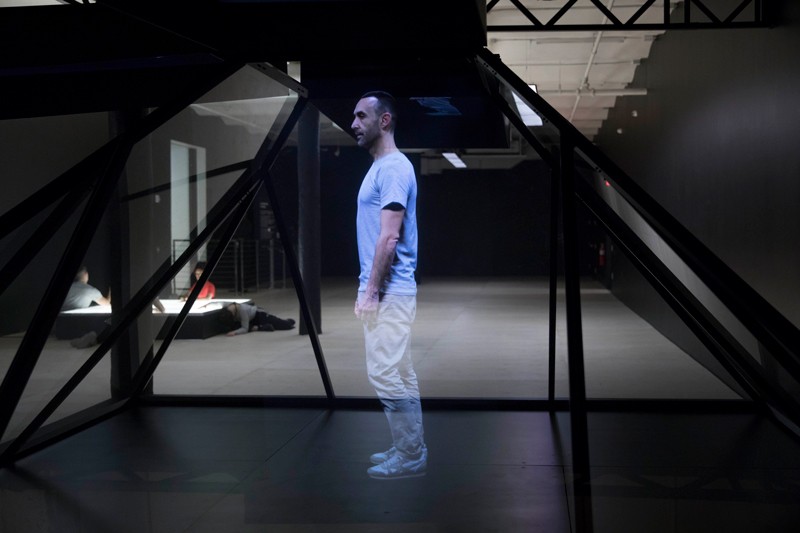If you’re lucky, your visit to the New Museum’s ground floor will begin with the sound of an aria from Madama Butterfly. Venture into the nearby South Galleries and you’ll see between one and five dancers seducing visitors with balletic gestures and recitations, cast with the dampened glow of an adjacent technicolor hologram. The particular iteration that I caught involved a steady stream of limbs atop a glowing podium: performers’ hands wriggled robotically, sometimes gesticulating, sometimes roving abstractly. Immediately afterward, another performer dictated a meditation on the complex network of co-evolution and sociality in microorganisms, which was followed by yet another slinky configuration of eyes, hands, nose, and fingers. This time, the material reference was not immediately clear, if it even existed at all. Our hologram, impervious to muscle fatigue, kept dancing.
Our hologram has a name: Farid Fairuz. Farid Fairuz is the disembodied co-star in Alexandra Pirici’s Co-natural, an “ongoing action” performance that consists of several dancers and one hologram. Farid is the permanent alter ego of the Romanian cultural critic and choreographer formerly known as Mihai Mihalcea, a persona born out of his oneiric performance work, REALIA (2013). The work was a response to the Romanian Ministry of Culture’s failure to find a new home for the country’s National Center of Dance in Bucharest, instead redirecting funds to the erection of ethically dubious and decidedly Eurocentric state monuments. This eventually culminated in a socio-political movement and sit-in called Occupy CNDB, of which Pirici was a part. In response to the state’s provincialism, Pirici mounted choreographic interventions alongside city monuments titled If You Don’t Want Us, We Want You (2011)—an early foray into dance as protest.
Co-natural’s focus on Romania’s cultural apparatus is especially apparent in Farid’s holographic presence. Responding to the geopolitical reality of her post-Soviet upbringing, Pirici resists bored ideas of dance-as-entertainment in favor of the corporeal activities of her actors. Culling from a host of iconic poses across art history, Pirici creates a patchwork of abstractions that register somewhere between ornamental choreography and historiography. In a move that feels distinctly parafictive, controversial monuments—such as Gaetano Russo’s Christopher Columbus sculpture on view in Central Park—take on the lighter air of their hosts. Dancers sit on the lightbox and lurch their hands one above the other in an unending stack, insinuating factory work. Another dancer interfaces with the hologram’s demure activity, while two more scuttle and scoop their bodies together, preparing another intimate portrayal. It all feels mechanically over-determined but in a manner shrewdly aware of the Soviet cultural transcript that identity is not a major organizer of social and political actions.
The constellation of bodies tweaks our sense of time and the possibilities of a single unit, like a bouillon cube melting into soup. Pirici makes no assumptions about the significance of her referents except in the idiosyncrasies of their juxtaposition. The performers’ enactment of Antonio Canova’s Psyche Revived by Cupid’s Kiss (1787), a neoclassical sculpture that marked a shift towards the emerging movement of Romanticism, occurs at the same time as a dictation about the symbiotic relationship between bacterial and human health.
For Pirici, the point is less to exhibit the designs of her highly skilled dancers (and hologram), as it is to highlight the increased fragmentation between images and a body. The fragmentation here also extends to the palindromic structure of the work, which ramps up and slows down daily on a seven-hour cycle. The hologram is on a one-hour loop and dances alone on either end of that cycle. My personal favorite reconstructive play is that of Édouard Manet’s Le Déjeuner sur l’herbe (1863), a painting that sparked controversy with its depiction of an overly sexualized woman. Dancers enact the scene: a man is seated on the grass reclining, his legs wide. Next to him, a nude woman subtly intertwines her legs between his. She breaks the fourth wall—so too do the dancers. There are enough examples of contemporary misogyny for this reference to stand, but whether you know it or not doesn’t matter. The metanarrative darkens the mood, and while the performers negotiate agency with sweeping intimacy, you—among the writhing cohort and the interlocutor hologram—can sense it.
The ceaseless emissions of the hologram foil the biological needs of its human counterparts, evidenced by the latter’s routine bathroom breaks, or the tremble of their muscles by day’s end. Performers reconfigure their impulses and time their exits, joining the choreographic dramaturgy. It would be exhausting to garner meaning out of each motif, and though the postmodern collage can be overbearingly dense at times, the overall effect works. The exhibition is best read as an update to the expectation that performance in this region possesses a narrative of authoritarianism. Pirici chooses instead to broadcast a modular and dynamically changing set of agencies. A performer shifts her weight from one foot to the other, the podium creaks, and we bear witness to the same dictation on micro-organic society on yet another scale: the human one.
